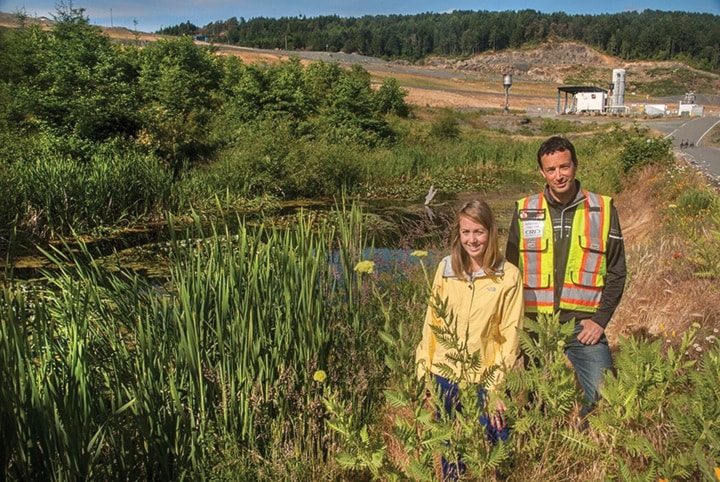A family of ducks swims to the edge of a freshwater pond and waddles up a slight embankment to enter a growing forest of Douglas fir trees. The air smells clean, as a light breeze passes through the expansive site in rural Saanich.
This isn’t the land surrounding Prospect Lake or a daylighted section of Tod Creek – these are the grounds occupied by Hartland landfill.
Below those ducks’ feet is 40-plus years worth of garbage – 50 metres deep and 4.5 million cubic metres of it. But you would never know it from the surface.
This is Phase 1 of Hartland landfill. When it was filled to capacity in 1998 it was closed and covered up. Now it’s in the process of being transformed back into a forest.
“If you can visualize it, we’re on a whole bunch of garbage right now. Then on top of that is 10 feet of dirt, then this two-inch piping lays across the entire footprint, then on top of that is a big, geotextile membrane, and then on top of that membrane is another 10 to 15 feet of dirt, and then we reforest it with native plants,” says Drew Fafard, supervisor of safety and technical services for Hartland operations.
The reforestation is a long-term project that began at the landfill in 2004. In the decade since, more than 25,000 native trees and plants have been planted on the site.
“Eventually when everything’s closed, you’re not going to know this was a landfill,” says Monique Booth, supervisor of communications and education for Capital Regional District environmental services.
The goal is for the landfill footprint to eventually blend seamlessly with the forested area and Mount Work Regional Park that shares a border with the property.
Hartland landfill is divided into two phases. All of the Capital Region’s garbage that’s sent to the landfill today (and since April 1997) is deposited in Hartland Phase 2.
It’s that phase that’s currently slated to be full – 10.3 million cubic metres of garbage – by 2049. But Booth says that deadline could potentially be pushed back indefinitely if people follow the three Rs: reduce, reuse, recycle.
“It might not ever be full; if diversion rates keep going up. But I think once it’s full and closed, we’re going to be transitioning back to the natural environment surrounding the site,” she says. “Right now we’re in the middle of our solid waste management plan, and that’s something we’re going to look to the community on. We really feel like this is our region’s landfill and it’s our region’s decision on what happens to it in the future.”
This weekend, the landfill hosts Hartland Happening, a behind-the-scenes event that gives residents in the Capital Region a better understanding of where their garbage goes and what’s going on at the landfill.
“I like to think of it as, ‘Come say hello to away.’ People throw away so much stuff, and it really doesn’t go that far away,” Booth says. “If you grew up in Victoria, everything you’ve ever thrown away you can go and wave to at Hartland. From your diapers when you were a baby to that plastic bag last week.”
Visitors to Hartland Happening will be able to take a guided bus tour of the landfill, and there will be info booths on site to learn about all the projects at Hartland. Kids will be able to play in a giant sandbox and see a live hawk up close. (The bird of prey is brought to the landfill nearly every day to scare away seagulls, preventing them from treating the active landfill site as an easy food source.)
Hartland Happening aims to be a zero-waste event, and encourages all visitors to bring a reusable water bottle. Napkins, plates and cutlery that will come with food sold at the event – courtesy of Mr. Tube Steak – are all compostable or recyclable.
“Nothing used on the day will actually go up to the landfill,” Booth says.
Parking at the landfill is limited, but the CRD offers a frequent shuttle bus service from parking lot 5 at Camosun College’s Interurban campus (4461 Interurban Rd.).
Hartland Happening runs from 10:30 a.m. to 2 p.m. on Sunday (June 22) at 1 Hartland Ave.
For event info, or to reserve a spot on a shuttle bus, visit crd.bc.ca/hartlandhappening.
editor@saanichnews.com
••••
Did you know?
• The two-inch piping underground that Fafard mentioned is part of a vacuum system that collects methane produced by the decomposing organic waste. The gas is sent to an on-site plant that burns the methane, converting it to electricity. That electricity is sold to BC Hydro and helps power 1,600 Greater Victoria homes annually.
• When the province introduced a new blue box recycling program earlier this year, the Capital Regional District removed a $6 entrance fee to recycle certain items at Hartland, including Styrofoam blocks, paint cans, batteries and small appliances. The fee still applies to items like ferrous and non-ferrous metals, tires and large appliances.
